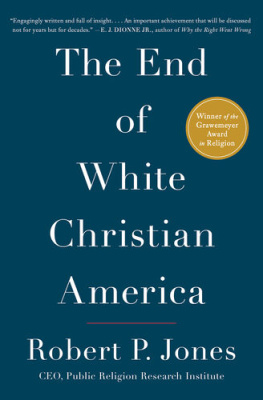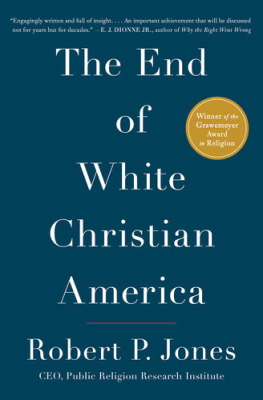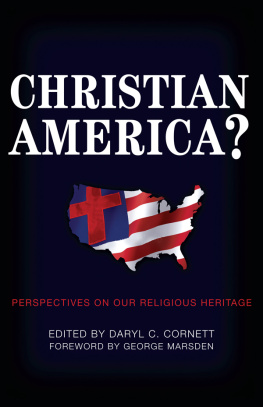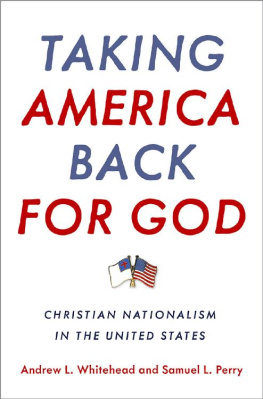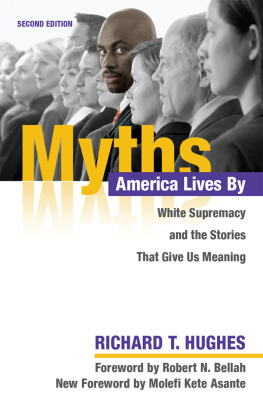We hope you enjoyed reading this Simon & Schuster eBook.
Join our mailing list and get updates on new releases, deals, bonus content and other great books from Simon & Schuster.
C LICK H ERE T O S IGN U P
or visit us online to sign up at
eBookNews.SimonandSchuster.com
Thank you for downloading this Simon & Schuster eBook.
Join our mailing list and get updates on new releases, deals, bonus content and other great books from Simon & Schuster.
C LICK H ERE T O S IGN U P
or visit us online to sign up at
eBookNews.SimonandSchuster.com

RANDY BACON
ROBERT P. JONES is the founding CEO of the Public Religion Research Institute (PRRI) and a leading scholar and commentator on religion and politics. He is the author of two previous books and numerous articles on religion and public policy. Jones writes a column for The Atlantic online on politics, culture, and religion. He also appears regularly on Interfaith Voices , the nations leading religion news-magazine on public radio. Jones is frequently featured in major national media such as CNN, MSNBC, NPR, The New York Times , The Washington Post , and others.
MEET THE AUTHORS, WATCH VIDEOS AND MORE AT
SimonandSchuster.com
authors.simonandschuster.com/Robert-P-Jones
ALSO BY ROBERT P. JONES
Progressive and Religious: How Christian, Jewish, Muslim, and Buddhist Leaders Are Moving Beyond the Culture Wars and Transforming American Public Life
Liberalisms Troubled Search for Equality: Religion and Cultural Bias in the Oregon Physician-Assisted Suicide Debates

Simon & Schuster
1230 Avenue of the Americas
New York, NY 10020
www.SimonandSchuster.com
Copyright 2016 by Robert P. Jones
All rights reserved, including the right to reproduce this book or portions thereof in any form whatsoever. For information address Simon & Schuster Subsidiary Rights Department, 1230 Avenue of the Americas, New York, NY 10020.
First Simon & Schuster hardcover edition July 2016
SIMON & SCHUSTER and colophon are registered trademarks of Simon & Schuster, Inc.
For information about special discounts for bulk purchases, please contact Simon & Schuster Special Sales at 1-866-506-1949 or .
The Simon & Schuster Speakers Bureau can bring authors to your live event. For more information or to book an event contact the Simon & Schuster Speakers Bureau at 1-866-248-3049 or visit our website at www.simonspeakers.com.
Interior design by Ruth Lee-Mui
Jacket design by Alison Forner
Illustration by Tim Duffy
Library of Congress Cataloging-in-Publication Data
Names: Jones, Robert P. (Robert Patrick), author.
Title: The end of White Christian America / Robert P. Jones.
Description: First Simon & Schuster hardcover edition. | New York : Simon & Schuster, 2016. | Includes bibliographical references and index.
Identifiers: LCCN 2015041178| ISBN 9781501122293 | ISBN 1501122290 | ISBN 9781501122330 (ebook)
Subjects: LCSH: Religion and politicsUnited StatesHistory. | United StatesHistoryReligious aspectsChristianity. | United StatesRace relationsHistory. | WhitesUnited StatesHistory.
Classification: LCC BL65.P7 J66 2016 | DDC 200.973dc23 LC record available at http://lccn.loc.gov/2015041178
ISBN 978-1-5011-2229-3
ISBN 978-1-5011-2233-0 (ebook)
To my parents,
Pat and Cherry Jones
Contents
An Obituary for White Christian America
After a long life spanning nearly two hundred and forty years, White Christian Americaa prominent cultural force in the nations historyhas died. WCA first began to exhibit troubling symptoms in the 1960s when white mainline Protestant denominations began to shrink, but showed signs of rallying with the rise of the Christian Right in the 1980s. Following the 2004 presidential election, however, it became clear that WCAs powers were failing. Although examiners have not been able to pinpoint the exact time of death, the best evidence suggests that WCA finally succumbed in the latter part of the first decade of the twenty-first century. The cause of death was determined to be a combination of environmental and internal factorscomplications stemming from major demographic changes in the country, along with religious disaffiliation as many of its younger members began to doubt WCAs continued relevance in a shifting cultural environment.
Among WCAs many notable achievements was its service to the nation as a cultural touchstone during most of its life. It provided a shared aesthetic, a historical framework, and a moral vocabulary. WCAs vibrancy was historically one of the most prominent features of American public life. While the common cultural ground it offered did not prevent vehementor even bloodyconflicts from erupting, the lingua franca of WCA gave them a coherent frame.
As the nation was being born, George Washington invoked WCA in his first inaugural address. And when it was being torn apart during the Civil War, WCA provided biblical themes and principles that called the nation back to its highest ideals. Without WCA, neither Abraham Lincolns second inaugural address nor Martin Luther King, Jr.s, Letter from Birmingham Jail could have been written, let alone understood. Virtually every American president has drawn from WCAs well, particularly during moments of strife.
During its long life, WCA also produced a dizzying array of institutions, from churches to hospitals, social service organizations, and civic organizations such as the Boy Scouts, Girl Scouts, and the YMCA. Beyond these direct functions, WCA also helped incubate and promote the missions of countless independent nongovernmental organizations that met in its facilities and were staffed with its members. Widespread
But WCA has not been without its critics and controversies. Its reputation was especially marred by its general accommodation to and participation in the institution of slavery up until the Civil War. In the late nineteenth and twentieth centuries, WCAs apathy towardand in some quarters even staunch defense ofsegregation in the American South did little to overturn these negative associations. Its credibility was also damaged when it became mired in partisan politics in the closing decades of the twentieth century. Late in its life, WCA also struggled to adequately address issues such as lesbian, gay, bisexual, and transgender (LGBT) rights, which were of particular importance to its younger members, as well as to younger Americans overall.
WCA is survived by two principal branches of descendants: a mainline Protestant family residing primarily in the Northeast and upper Midwest and an evangelical Protestant family living mostly in the South. Plans for a public memorial service have not been announced.
1
Who Is White Christian America?
White Christian Americas Life in Architecture
As visitors ascend to the observation deck of One World Trade Center in New York City, they face three floor-to-ceiling video panels, arranged to mimic the feel of a glass-walled elevator. While the elevator climbs 102 floors in 47 seconds, they watch, in time-lapse video, the visual history of the landscape from their current vantage point. After a view of the undeveloped marshes of Manhattan Island in the early 1500s, the low-rise gabled buildings of Dutch settlers in New Amsterdam appear in the simulated panoramic view. Ships fan out in the harbor during the British colonial period, and familiar bridges and skyscrapers begin to appear as the city expands to fill the horizon in the nineteenth and twentieth centuries.
Next page

